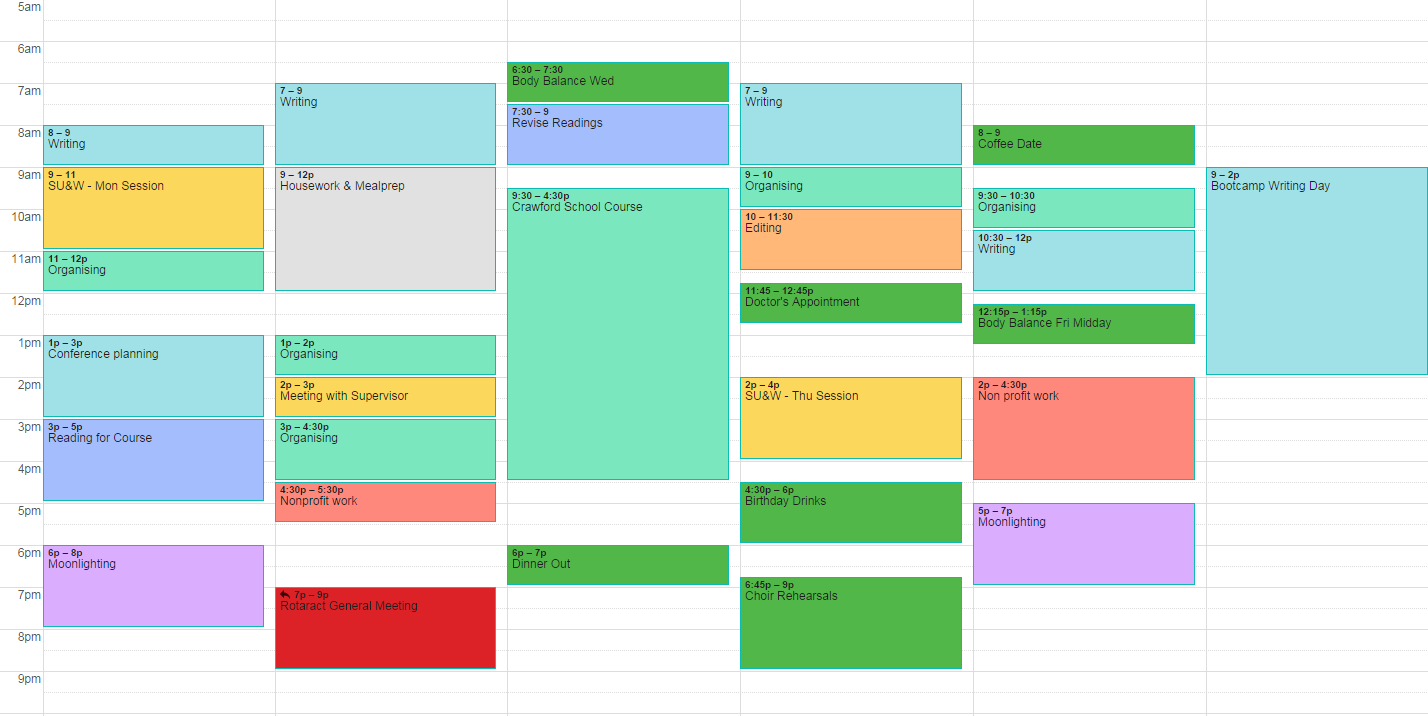Thinking Inside and Outside the Box – Finding a Realistic Academic Schedule
Today in our series of academic schedules, I’m inviting Jennifer Upchurch. Jennifer is an Australian Sociology PhD Candidate. Her PhD research is on young people and their experiences of civic participation in groups. She tweets at @jamandcrumpets.
I started my PhD whilst a friend was half way through her candidature. I would watch in amazement at the variability of her office hours, but how regular they became over time as the pressure hit. One method she had for getting things done was what we called the Stupid-Early Work Day: wake up at 4am and head into the office to start work by 5:30. Stupid-Early was very useful for short sprints of work, but ultimately completely unrealistic; we could only do it for a few days a week before we both collapsed!
Looking back, my conversion into the cult of Stupid-Early was an attempt to deal with the somewhat paralysing lack of structure of the PhD experience. I could do anything at any time and have any kind of schedule and no one would stop me! *cue evil laugh* This is a problem for many PhD students I know; they have told me it means they don’t see their PhD as a “real job” and they look for self-efficacy that a “real” structured job brings them. Sometimes this even happens in the form of “workrastination”, an excellent term a friend came up with to describe busying yourself with part-time or non-profit work that isn’t your PhD. But I’ve also learned the foibles of a PhD mean it will never give me the structure of a “real” job; it’s a funny study/work/apprenticeship hybrid creature. My answer to this has been to create a schedule and approach to project management that is also a funny hybrid creature.
The thing that began to give my PhD week a much clearer structure was joining a writing group at my university called Shut Up And Write!. The group writes for 25 minute bursts in silence followed by 5 minute breaks (aka the Pomodoro Technique). I’ve noticed this philosophy of “time boxing has flowed over to other areas of my PhD work. Falling into the role of co-convenor of the group has meant I have at least four hours a week I have to devote to writing, because I have to be there most of the time to facilitate the group! I started blocking out this time in my week and planning for it, then I began scheduling everything else out around it. This enabled me to devote “sacred” time for writing, as I began to understand that a writing routine is important. Plotting a little coloured box on a Google calendar means I can better limit my focus to that type of activity, because I know the time is limited by the other coloured boxes around that task. It’s simple trickery but it works well as long as you don’t overthink it!
My Wreckable Template:
Three months ago, I came across Eva’s post on Google calendar scheduling and I’ve incorporated it into how I plan my workflow. The key thing that made me switch to Google Calendar from a paper diary is that Google calendar lets you drag events around into different timeslots. This might seem really obvious and simple, but it’s a really useful way to both block out my week and adapt to changes and obstacles.
Raul Pacheco-Vega’s weekly template inspired me to create my own. I figured out the types of things I needed to get done and made them into recurring events in Google Calendar:
Being Realistic – Thinking Outside the Boxes
Essentially this process for me is a form of managing without micromanaging; it’s scheduling but not to the minute (as Eva found is very difficult) and it lets me acknowledge that there is no perfect week. What it does allow for is training myself to be able to cope with writing more and more as I hunker down for thesis writeup in my final year. As time goes on, I’m doing less dragging around of boxes and there are less gaps in between tasks. I am also adjusting the weekly template itself based on what works for me. Basically even being mindful of how I work gives me self-efficacy. It has let me think about what my limits are and what a good day of PhD work looks like for me.




Well written and insightful